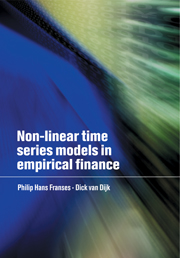4 - Regime-switching models for volatility
Published online by Cambridge University Press: 14 May 2010
Summary
Uncertainty, or risk, is of paramount importance in financial analysis. For example, the Capital Asset-Pricing Model (CAPM) (Sharpe, 1964; Lintner, 1965; Mossin, 1966; Merton, 1973) postulates a direct relationship between the required return on an asset and its risk, where the latter is determined by the covariance of the returns on the particular asset and some benchmark portfolio. Similarly, the most important determinant of the price of an option is the uncertainty associated with the price of the underlying asset, as measured by its volatility.
One of the most prominent stylized facts of returns on financial assets is that their volatility changes over time. In particular, periods of large movements in prices alternate with periods during which prices hardly change (see section 1.2). This characteristic feature commonly is referred to as volatility clustering. Even though the time-varying nature of the volatility of financial assets has long been recognized (see Mandelbrot, 1963a, 1963b, 1967; Fama, 1965), explicit modelling of the properties of the volatility process has been taken up only fairly recently.
In this chapter we discuss (extensions of) the class of (Generalized) Autoregressive Conditional Heteroscedasticity ((G)ARCH) models, introduced by Engle (1982) and Bollerslev (1986). Nowadays, models from the GARCH class are the most popular volatility models among practitioners. GARCH models enjoy such popularity because they are capable of describing not only the feature of volatility clustering, but also certain other characteristics of financial time series, such as their pronounced excess kurtosis or fat-tailedness.
- Type
- Chapter
- Information
- Non-Linear Time Series Models in Empirical Finance , pp. 135 - 205Publisher: Cambridge University PressPrint publication year: 2000



